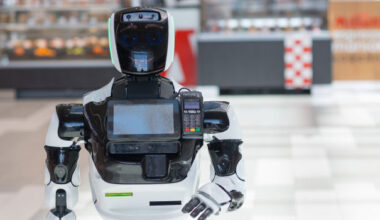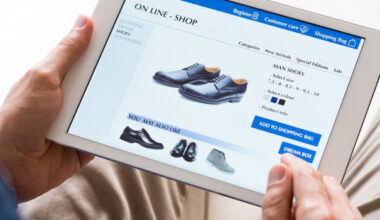
With the rise of online retail activities, the retail industry is experiencing a wave of business upheaval. However, the COVID pandemic hit the retail industry as well as online retail’s rapid expansion. It is for this reason that merchants throughout the world are striving to implement AI in the retail industry.
Let’s take a look at how retailers are leveraging cutting-edge technologies such as Augmentation, Artificial Intelligence, and Machine Learning to stay ahead of their competition today, and what innovations are being pioneered as possible game-changers in retail over the next decade.
1. Recommendations for Products Based on Clients’ Purchasing Habits
Users will be able to create accounts in retail locations by following the same procedures as they do online. Stores have taken some steps to make this easier, such as allowing customers to pick up their purchases, get them delivered, and keep track of their points. This makes it easier for store employees to cater to the unique needs of each customer who enters the store. The types of things you buy, the combinations you buy, the brands you favor, the amount you spend, and how often you buy, all play an important role in determining your purchasing habits. To date, the emphasis has been on making product recommendations. Additionally, this approach can foretell customer demands and predict their arrival to the physical stores and online stores with a specific set of items to purchase, which is a ground-breaking approach.
2. Expansion of the Consumer Base with High-Value Services
Customers create their trust in a brand based on product quality, pricing, delivery, and response services. People are more likely to come into the store if the brand is well-known. Your brand’s ability to retain and attract new customers is a hot topic in the industry. Prompt customer service increases consumer traffic in the business since it demonstrates a company’s commitment to meeting the needs of its clients.
Customers can get answers to their questions through AI-enabled in-store assistants, which create a strong communication channel. There are no better examples of AI innovation in the retail industry than digital assistants powered by artificial intelligence (AI).
3. Inventory Management and Demand Forecasting
Product profiling can be done in the same way as customer profiling. Which items people choose to buy in what combination and what quantity, as well as the position in the actual store where this product is stored, are all factors in determining how much of this product is accessible at any one time. The goal is to ensure that this product is always sold in conjunction with other products and that the ideal quantity of the product is always available in the store. AI may be used to create efficient models, and the results can then be displayed on a dashboard enabling the store operator to take the proper measures towards the inventory.
4. Product Bundling and Pricing Strategy
Much of the work done in retail centers is on product pricing. For non-urgent items, customers wait for the price to drop before making a purchase. They also wait for things to arrive in combination at an appropriate price. For a short period, this can lead to greater sales and higher income; on the other hand, sales at prices below the procurement price might lead to overall unprofitable sales. In order to get the best price for a certain group of clients, AI can identify the price that will compel them to make an immediate purchase. Another group of clients can benefit from AI’s ability to recommend a product combination at a reasonable price. AI will be able to ensure the strategy’s profitability as it is being developed.
5. Chatbots for Customer Service Assistance
In addition to providing better customer support, AI chatbots also help with the search, send alerts about new collections, and make suggestions for related items. For example, a chatbot can advise an appropriate snapback to go with a black hoodie a consumer has already purchased. AI chatbots are already being used by 80% of global brands or will be in the near future. Chatbots have been deployed by Tommy Hilfiger and Burberry to help customers navigate their collections.
6. Logistics and Supply Chain Management
Retailers throughout the world lose around $1.1 trillion a year as a result of subpar execution in this area. It’s possible to avoid having leftovers or running out of supplies. When it comes to retail supply chain refilling, artificial intelligence (AI) may be utilized by taking into account factors like past sales, location, weather, trends, promotions, and more.
7. Search Visually
Customers can upload photographs and search for similar products based on color, shape, and pattern using visual search engines driven by artificial intelligence. Cortexica’s image recognition system claims a 95% accuracy rate. 90% of customers gave the Discover Similar feature a thumbs up. American Eagle’s infrared technology makes use of Visual Search, which not only directs customers to similar or identical clothing but also suggests complementary items.
8. Virtual Changing Rooms
We can’t forget about this amazing FUNCTION. With virtual fitting rooms, buyers can select the right outfit with all of the elements properly matched in a matter of minutes instead of spending hours searching. AI has developed a virtual fitting kiosk that can scan you in 20 seconds and measure 200,000 points of your body in this time. The installation of these scanners by retailers such as Levi’s, Gap, Brooks Brothers, Old Navy, and others resulted in significant gains in sales.
9. Voice Search
You can also use voice search to find what you’re looking for. Several major retailers utilize Google or Amazon AI technology to make voice search simple and fast for customers. Using Alexa, users can simply ask for the item they’re looking for and its delivery status without having to type anything at all. 27% of the world’s population use the voice service, while 52% prefer the browser search in mobile apps and websites for convenience.
10. Assistance in the Store
For both customers and store employees, retailers are investing in cutting-edge technology. Smart shelf tags, made possible by Kroger Edge technology, have replaced paper price tags in their shops. Video commercials, nutritional data, and promotions can all be portrayed on the displays thanks to this new technology. A robot called Lowebot from Lowe’s helps clients locate what they’re looking for by speaking a variety of different languages. Due to its real-time monitoring capabilities, it also aids in inventory management.
Conclusion
One of the top Artificial Intelligence vendors claims that the implementation of AI in inventory management resulted in a 32% cost reduction across all operations. AI’s ability to improve supply chain management and return on investment is expected to save 80% of the money. According to respondents, chatbots and self-checkout systems will be most advantageous for retailers in terms of customer-facing functions. Over the next five years, the worldwide retail AI market is predicted to reach over $5 million dollars.






